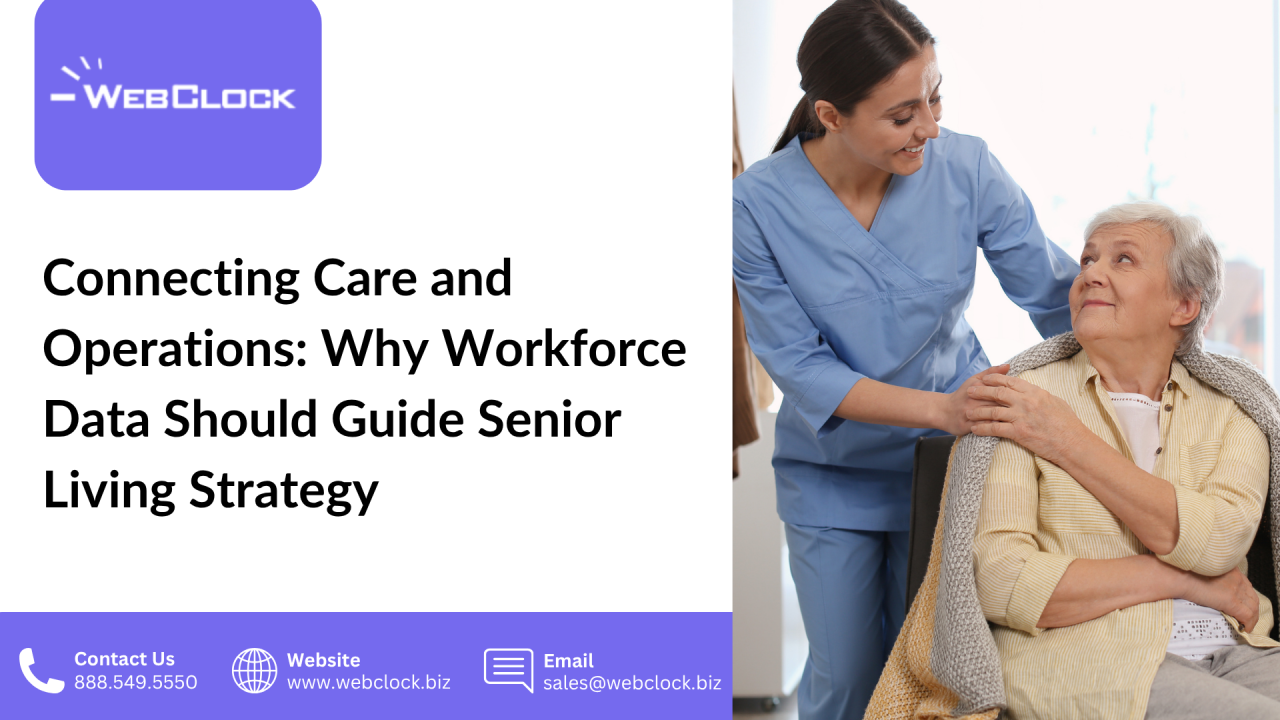Connecting Care and Operations: Why Workforce Data Should Guide Senior Living Strategy

In today’s senior living communities, delivering high-quality care while staying financially sustainable is a constant balancing act. Leaders are expected to manage rising labor costs, staff shortages, and increasing demand for transparency and accountability, all while keeping operations running smoothly.
Yet, despite these challenges, many senior living operators still lack access to real-time workforce data. They rely on outdated tools or fragmented systems that only show part of the picture. As a result, decision-making becomes reactive rather than strategic.
But it doesn’t have to be this way. When used effectively, workforce data becomes more than just numbers on a report, it becomes a powerful tool for driving better outcomes across care delivery, staffing, and financial planning.
Why Workforce Data Matters in Senior Living
Labor is one of the largest and most complex expenses in senior living. It directly affects resident care, staff morale, and operational performance. However, without reliable data on how staff are scheduled, how hours are worked, and where gaps are forming, leadership teams are forced to make decisions based on guesswork or delayed information.
The risks are clear:
- Overstaffing or inefficient shift coverage increases costs
- Understaffing can lead to burnout and declining care quality
- Untracked absences and missed punches can distort payroll and budgeting
- Lack of visibility makes it harder to respond quickly to changing resident needs
Real-time workforce insights eliminate these blind spots. They help senior living communities stay agile, control costs, and support staff more effectively.
What the Right System Reveals
Modern workforce management platforms go far beyond clock-ins and timesheets. They offer leaders a live, accurate view of their operations, enabling smarter decisions every day. Here’s what senior living leaders can gain from better visibility:
1. Actual vs Scheduled Hours
Instantly see how scheduled shifts compare to hours actually worked. This helps pinpoint where coverage is falling short or where overtime is creeping in.
2. Overtime and Fatigue Patterns
Track which employees are consistently picking up extra shifts. Identifying over-reliance on a few team members allows managers to rebalance workloads and reduce burnout.
3. Attendance Gaps and Trends
Spot patterns of absenteeism or late punches that may signal disengagement or compliance issues. Early detection allows for proactive coaching or support.
4. Cross-Facility Comparisons
For operators managing multiple sites, workforce data provides a consistent view across communities. Leaders can compare staffing levels, time usage, and labor costs to identify high-performing locations and areas for improvement.
5. Real-Time Alerts and Reports
Access dashboards that show what’s happening in real time. Whether it’s a missed shift or unexpected overtime, being alerted immediately means problems are solved before they escalate.
This kind of transparency empowers leaders to shift from reacting to problems to preventing them. It also strengthens communication between department heads, caregivers, and administrators, since everyone is working from the same accurate data.
How Workforce Insights Support Strategy
Workforce data is more than an operational tool, it is a strategic asset. Here’s how it helps senior living organizations at the leadership level:
Better Budget Planning
Historical and real-time labor data make it easier to forecast staffing costs, adjust scheduling practices, and align labor spend with census changes.
Faster, Informed Decision-Making
With access to live data, executives can make confident decisions faster, whether reallocating staff, adjusting shift structures, or responding to sudden staffing changes.
Improved Employee Satisfaction and Retention
When staff scheduling is fair, transparent, and reliable, employees are more engaged. Tools that give team members visibility into their hours and shifts also build trust.
Accountability Without Micromanagement
Workforce data helps managers hold teams accountable without constant oversight. Patterns are visible, reports are automated, and transparency becomes part of the culture.
Stronger Operational Control
Leaders gain a holistic view of their operations. Instead of reacting to staffing shortages or budget overruns after the fact, they can make adjustments in real time.
Why WebClock is Built for Senior Living Leaders
WebClock is designed to help senior living communities turn workforce data into strategic insight. Our cloud-based time and attendance platform gives leadership teams the visibility they need without adding complexity.
With WebClock, you can:
- Track time, attendance, projects, and time off in real time
- Monitor labor costs and shift trends from any device
- Automate timekeeping and reduce manual errors
- Compare performance across locations or departments
- Provide employees with a user-friendly interface to manage their time
Our platform integrates seamlessly with payroll and HR systems, ensuring data flows smoothly and reliably. And because it’s intuitive to use, your staff will adopt it quickly, reducing training time and disruption.
The Bottom Line
Senior living is a people-driven industry, and people need the right support to thrive. When leaders have clear, real-time insight into how their teams are working, they can make smarter, faster decisions that benefit residents, staff, and the bottom line.
Workforce data is no longer just an HR concern. It is the foundation for stronger operations, better care, and long-term success.
Get Started Today
Discover how ITCS-WebClock can streamline your time and attendance management. Save time, reduce costs, and stay compliant with our powerful yet easy-to-use solutions.

